
- GM China - common practices and global systems
- Upper segment boom
- Labour laws – improving but still restrictive
- Production equipment – German versus local
- Great Wall - a domestic tiger
- High strength from hand-welding and finishing
- Labour and skill sets
- Hyundai - dealing with demand
- New technologies increase speed
- Quality by numbers
In April 2009, the general consensus was that China’s economy, together with its auto industry, was slowing down. During 2008, the country’s gross domestic product slowed to 6.8% growth in the fourth quarter, down from 10.6% in the first quarter. Yet strongly bucking this trend, sales of locally-produced vehicles grew 6.9% in 2008 to 6.5 million units, following the 20%-plus growth of new car sales in 2006 and 2007.
This, despite growing competition, as Japanese and other transplant carmakers built on their momentum. In the face of this challenge, domestic carmakers launched a raft of new models and ramped up production.
While Toyota and Honda gained 19% and 11% respectively on their 2007 sales figures of locally-made vehicles, with Nissan growing a notable 28%, the picture was not so healthy for all the transplants. Sales for Ford and GM fell by 8% and 10% respectively in 2008. One of the main reasons for this was the Detroit Two’s lack of vehicles in the low-price segments, an area where the domestic brands are especially strong, particularly in the less-developed interior regions of the country.
GM China - common practices and global systems
Model Sales
1 Wuling Light/Sunshine/City Breeze 545,239
2 ChanganGreen Star 222,366
3 Hyundai Elantra 203,734
4 Volkswagen Jetta 202,303
5 Buick Excelle 175,470
6 Honda Accord 170,304
7 Toyota Corolla 165,270
8 Toyota Camry 152,834
9 Nissan Tiida 137,193
10 BYD F3 136,782
Source: JATO Dynamics
AMS started its tour of China with a visit to John Buttermore’s office in Shanghai where we discussed the success of GM cars of old in China, such as the legendary Buick Century, a favourite of party officials in the days when very few people in the country could afford a car. This very much American design stands in stark contrast with the new Lacrosse, a vehicle designed partly in China, developed to appeal to a global market. As with the design input, would there be some manufacturing system input derived from the many years of GM vehicle production in China. In response, Buttermore highlights the overriding global nature of the GM Manufacturing System: “A lot of the manufacturing systems (that GM uses) are very common, they are used everywhere else in the world and work with such things as extensive benchmarking, making sure that the manufacturing approach is competitive, follows best practices, is efficient and also that it is right for China.” Buttermore seems pleased with what he calls the skill set of the Chinese workforce: “The workforce here is very good, with a generally good standard of education across both our hourly and salaried workforce.”
As to buying machinery from suppliers in China, he is enthusiastic about the savings that can be made by buying equipment locally: “We have already started buying machines from local Chinese suppliers. I would say we carry out global purchasing, always striving to get the best global prices, but with regard to the local skills and availability of equipment.”
Given an unlimited budget, Buttermore says he would like to have higher-speed machining for his powertrain divisions: “I would like to see more hard turning as opposed to abrasive machining, being able to use heavier feeds at higher speeds. Of course this must go hand in hand with reliability and accuracy.”
 Upper segment boom
Upper segment boom
In October 2009, Mercedes-Benz set another sales record in China, the company’s sales rising by 78% to 6,600 units (October 2008: 3,700 units). Since the start of last year, Mercedes-Benz has held the position of being the fastest-growing premium brand in China. Perhaps surprisingly, China is now the biggest market for the S-Class, which is produced on a CKD basis. C- and E-Class models are built using the part-by-part system. To find out how the company is coping with this level of demand and how a luxury car maker transplant deals with all the challenges of working in a rapidly changing and developing location, AMS visited Beijing Benz- DaimlerChrysler and talked to Patrick Schwind, General Manager of Mercedes-Benz China Manufacturing (MBC).
Schwind has had a varied career with Mercedes, starting in the Mercedes truck division in Wörth am Rhein. He then moved to Tuscaloosa, Alabama in 1995, working for three years on planning and paintshop construction. Following this, Schwind moved to Rastatt for two years, engineering the powder slurry paintshop operations for the A-Class, which was followed by a three-year assignment in East London, South Africa for production of the C-Class. Then it was back to Alabama, where he played a key role in planning the paintshop for the R-Class before coming to China. Situated on a 14,000m2 manufacturing site, with an adjacent 20,000m2 logistics area, MBC employs 3,000 staff producing 20,000 cars per year. The ratio of plant to logistics footprint is testament to the difficulties of transporting components and finished vehicles across the vast Chinese interior, while it is also necessary for importing and sorting the jigsaw that is an S-Class CKD kit.
In sharp contrast to other regions where Mercedes- Benz has manufacturing operations, the distances and poor infrastructure found in China have a direct impact on production scheduling, as Patrick Schwind explains: “Cycle times are affected not only by demand fluctuations but also by our supply chain. We keep many varied inventory levels because some of our suppliers are so far away and are not always totally consistent in delivery times. Just-in-time has not really come to China for most carmakers.”
Mercedes’ operations have changed a great deal in China; from all CKD to what it calls ‘part-by-part’ production for the C- and E-Class. A lot of its ‘critical’ parts, particularly powertrain, are still coming from Germany. What does Schwind see for the future localisation of parts? “It is not just part by part. We have localised 40% of component buying, buying from within China. We have kept the critical parts: engines, axles, driveshafts and modules - including front corner modules - coming from Germany. Stamped parts can be made in any area of the world, as we are using presses and techniques that are the same as in Germany.” In the stamping and body-in-white areas, MBC has been able to draw on past experience gained from making Chryslers: “We have a lot of experience in stamping here in China, from our days of pressing body parts for the Chrysler Sebring and the 300,” says Schwind. “For body steel, we do stay with a German supplier, Thyssen Krupp, but we are supplied locally here in China.”
and E-Class. A lot of its ‘critical’ parts, particularly powertrain, are still coming from Germany. What does Schwind see for the future localisation of parts? “It is not just part by part. We have localised 40% of component buying, buying from within China. We have kept the critical parts: engines, axles, driveshafts and modules - including front corner modules - coming from Germany. Stamped parts can be made in any area of the world, as we are using presses and techniques that are the same as in Germany.” In the stamping and body-in-white areas, MBC has been able to draw on past experience gained from making Chryslers: “We have a lot of experience in stamping here in China, from our days of pressing body parts for the Chrysler Sebring and the 300,” says Schwind. “For body steel, we do stay with a German supplier, Thyssen Krupp, but we are supplied locally here in China.”
Labour laws – improving but still restrictive
Labour sourcing and management is considered by many incoming managers to be more difficult in China when compared to Western Europe; technical education and qualifications are not at as high a level as in, for example, Germany. Schwind: “The trade school system is different here from all of Europe and it is difficult finding the more specialised trades; people skilled in electrical engineering and robotics.
“We have a partnership with a local school, which started training in these fields in parallel with our start of production. We have had three groups of technicians from this programme and this has been very successful. The school has a German teacher who oversees the programme using German principles, and the teachers have viewed the plant here and put some of our needs into the curriculum.” The two-shift system at MBC had been dictated in part by local labour laws restricting shifts to eight hours, but due to the extraordinary demand for the C-Class, the company - after negotiation with local officials – has moved to three 10-hour shifts from December 2009.
It is a common goal of most transplant carmakers to reduce the number of expat workers as soon as possible, introducing local managers wherever practicable. Schwind has plans to include local labour in plant management as deeply as in any other region: “Ultimately we will see Chinese people at all levels in the plant, with just finance and quality departments having significant numbers of German or other European staff.”
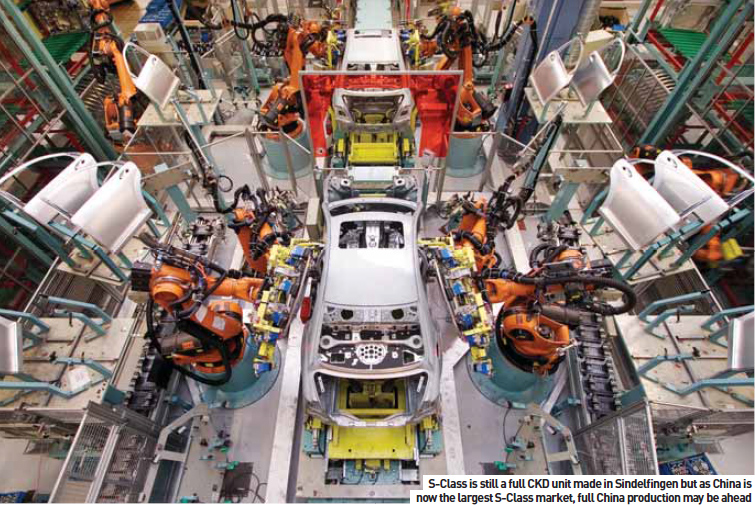 Production equipment – German versus local
Production equipment – German versus local
Currently, manual trolleys are used to move assemblies between stations. but demand is driving a move to increased automation in new parts of the plant. The new lines will be more automated, though not with AGVs, as there is sufficient space for dedicated conveyor lines.
As with many transplant operations in China, MBC continues to buy all its ‘critical’ equipment from traditional Daimler suppliers in Europe, but Schwind can see some opportunities for domestic machinery suppliers: “Whatever we can localise, such as power tools, jigs and fixtures, we will consider sourcing in China. We are building on the good relationships we founded in the Chrysler days.”
As production systems are homogenised globally for all carmakers, so advanced manufacturing techniques - such as laser welding - are increasingly being used across all plants of a given carmaker. Schwind sees China as being no different from other developing regions in this respect: “I am sure that laser welding is coming. At present we are at only 40% local parts content on the cars made here (excluding the CKD S-Class), and of course it is expensive to bring welded assemblies from Germany, so I can foresee bringing in more technology like this within the next couple of years.”
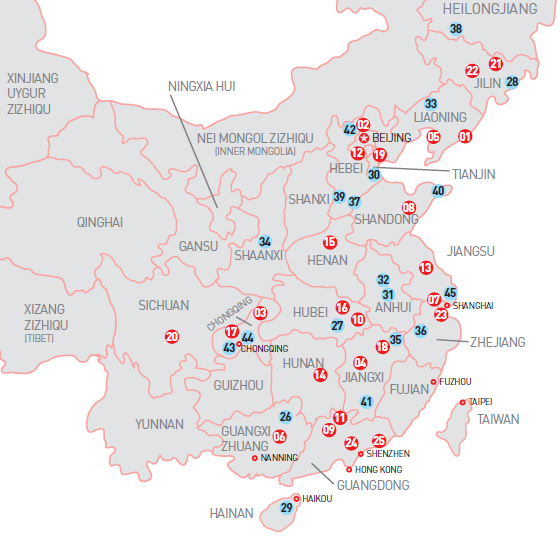 Transplants/JVs
Transplants/JVs
01 BMW Brilliance Automotive Shenyang
02 Beijing Benz-DaimlerChrysler Automotive
03 Changan Ford Mazda Automobile
04 Jiangling Motors Corp. Nanchang
05 Shanghai GM (Shenyang) Norsom Motors, Shenyang
06 SAIC-GM-Wuling Automobile, Liuzhou
07 Shanghai General Motors, Shanghai
08 Shanghai GM Dongyue Motors, Yantai
09 Guangzhou Honda Automobile, Guangzhou
10 Dongfeng Honda Automobile, Wuhan
11 Honda Automobile (China), Guangzhou
12 Beijing Hyundai Motor, Beijing
13 Dongfeng Yueda Kia Automobile, Yancheng
14 Hunan Changfeng Motor, Changsha
15 Zhengzhou Nissan Automobile, Zhengzhou
16 Dongfeng Peugeot Citroen Automobile, Wuhan
17 Chongqing Changan Suzuki Automobile, Chongqing
18 Jiangxi Changhe Suzuki Automobile, Jingdezhen
19 Tianjin FAW Toyota Motor, Tianjin
20 Sichuan FAW Toyota Motor, Chengdu
21 Sichuan FAW Toyota Motor, Changchun
22 FAW-Volkswagen Automotive, Changchun
23 Shanghai Volkswagen Automotive, Shanghai
24 Dongfeng Nissan Passenger Vehicle, Guangzhou
25 Guangzhou Toyota Motor, Guangzhou
Chinese OEMs
26 Dongfeng Liuzhou Motor, Liuzhou
27 Dongfeng Automobile, Xiangfan
28 FAW Car, Changchun
29 FAW Haima Automobile, Haikou
30 Tianjin FAW Xiali Automobile, Tianjin
31 Chery Automobile, Wuhu
32 Anhui Jianghuai Automobile, Hefei
33 Shenyang Brilliance Jinbei Automotive, Shenyang
34 BYD Auto, Xian
35 Jiangxi Changhe Automobile, Jingdezhen
36 Zhejiang Geely Automobile Group, Hangzhou
37 Great Wall Motor, Baoding
38 Hafei Motor, Harbin
39 Hebei Zhongxing Automobile, Baoding
40 Rongcheng Huatai Automobile, Rongcheng
41 Jiangxi Jiangling Holding, Nanchang
42 Beijing Automobile Works, Beijing
43 Chongqing Changan Automobile, Chongqing
44 Chongqing Lifan Automobile, Chongqing
45 SAIC Motor, Shanghai
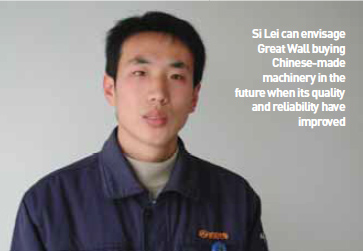 Great Wall - a domestic tiger
Great Wall - a domestic tiger
Great Wall’s plant in Baoding is a good example of how Chinese domestic OEMs have adopted the best of Western manufacturing systems, automating where advantageous and using the ample amount of land available to build a model plant. The facility incorporates every stage of automotive design, development and production, from concept and production vehicle design and modelling to crash testing and environmental lifecycle evaluation.
The company is almost 100% vertically integrated, with its own plastic moulding division, seat manufacturing, powertrain and stamping die-making centre. The site at Baoding is spread over 700 acres, with plans to expand to 2,600 acres as production ramps up to meet demand. Great Wall offers a range of 13 vehicles, from the Gwperi compact, at 3.5 metres long, to the Hover limousine, measuring 6.7 metres in length. The company also has two electric cars in development.
Great Wall employs about 20,000 people in four plants and supplier parks across China, the latter incorporating the company’s own ‘inner decoration’ company producing interiors and plastic parts, together with divisions making electrical components, chassis, engines and transmissions. The plant is divided into two main production units, each with full vehicle-making capabilities including stamping, welding, paintshop and assembly. These are referred to as No. 2 and No. 3 Manufacturing Departments, where No. 2 has a capacity of 10,000 units per annum (upa) and produces larger vehicles such as the Hover CUV and Wingle pick-up, while No. 3 is capable of producing 200,000 upa, including smaller passenger cars such as GWPeri, Florid, Coolbear, Phenom and the Great Wall mini-SUV.
Great Wall buys its steel from the Anshan Steel and Iron company and uses Müller Weingarten and JIER press lines laid out by ABB, with capacities ranging from 630 to 2,000 tons. Press dies are designed and made in-house in the 36,500 square-meter dies tooling centre. Autoform and Dynaform software in CAE simulation analysis are used to design the moulds which are modelled in FMC and then machined on Toshiba MPC 3150B digital control gantry 5-axis, Rambaudi 5-axis and Okuma MA-600HB machining centres. An NTC 5-axis laser cutter is used to cut out mould test pieces and the company is trying out a Makino EDNC157 spark erosion machine for more intricate mould making.
Such expensive and sophisticated techniques are part of the company’s drive for quality and efficiency as Si Lei, BIWTechnical Department Section Chief told AMS: “We are highly vertically integrated for many reasons, but mainly to keep costs down and to have better control of our supply chain.” Lei does not see the company buying production equipment from Chinese suppliers in the future: “At present, we do not have the level of quality equipment available from Chinese suppliers but with the development of the industry here, we will probably see machinery from the home market come up to the quality and reliability levels that we require.” Many of the ‘soft’ skills and systems found in plants in other global regions are also missing from the Chinese manufacturing landscape says Lei: “I would like to see more use of MRP, ERP and MES, particularly at suppliers. These disciplines are missing from some suppliers and as demand goes up, they will suffer from not organising their stock and supply chain properly.”
High strength from hand-welding and finishing
Lei reveals that Great Wall uses no high strength steel in its vehicles: “At present we do not have a high strength steel strategy, but we know that this will be necessary for the future.”
While Motoman robots are plentiful in the body-in-white cells, there is still a lot of hand welding in the plant. Lei says that there are plans to fully automate all weld lines in the next phase of line building: “For the next new model, CH031, we will have a fully-automated weld line with robotised spot weld capabilities. To maintain quality at high production levels, we know we have to automate further.” Although Lei would like to see lasers in BIW, he says that there would be problems in setting up such technology. “I am not sure that I would have the time to set up and perfect a laser weld line, as demand is so high that try-out time is at a premium!”
Labour and skill sets
Sourcing engineers with the correct training appears to be a problem throughout the automotive industry in China, but Great Wall seems to have a considerable allure for the skilled worker; many are willing to travel a long way across the vast country to work there. Says Lei: “We have about a 70% skilled workforce and around 20% semi-skilled. The remainder are what we call ‘greenhands’, who are first trained by us in a classroom situation, tested, and if they pass they are assigned to a ‘master’ or teacher on the shop floor. The master trains them in the practical skills and they then sit another examination. If they pass this, they start work in the plant.”
 Labour mobility - or churn - is not as high in China as in other regions such as India, as there is a strong company culture. “In the automotive industry in China and in Great Wall in particular, we do not see so much mobility,” says Lei. “Many people start with us when they are not skilled, and they will either stay or go to college to become engineers and return to us. We have a churn of about 5%. Also we have very good benefits and a strong company culture which people seem to like to be part of.”
Labour mobility - or churn - is not as high in China as in other regions such as India, as there is a strong company culture. “In the automotive industry in China and in Great Wall in particular, we do not see so much mobility,” says Lei. “Many people start with us when they are not skilled, and they will either stay or go to college to become engineers and return to us. We have a churn of about 5%. Also we have very good benefits and a strong company culture which people seem to like to be part of.”
Hyundai - dealing with demand
To understand how carmakers in China are dealing with the tremendous upswing in demand, we spoke with several senior executives at transplant OEMs in order to get a comparative view from managers experienced in other markets. Li JiKai, Vice-President, Production Department Manager, Beijing Hyundai Motor Company explains how he intends to deal with the constantly rising demand curve: “First of all, we are trying to increase our productivity and our plant utilisation; we are running at an average of 100%, some sections of the plant are running at 102%. We have calculated that each person in the plant can produce 80 cars per year, this is a very high output level for China.”
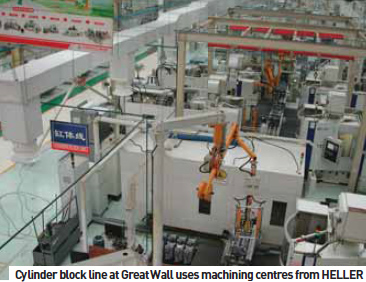 New technologies increase speed
New technologies increase speed
Owing to the fact that many car plants in China are relatively new, they have a wealth of state-of the-art production equipment. Asking manufacturing chiefs what they might buy if they had an unlimited budget, or at least what technology might make a significant improvement to their plants was sometimes met with a blank look. Li JiKai: “Our first plant here is seven years old and our second plant is just two years old, so the machinery and equipment we use now is right up to date.
“In the bodyshop, for example, we have more than 250 robots, giving an automation rate of up to 100%. In the press shop, we have 5,400 tons of press capacity. So we don’t really think about new technology so much. One area where we are making a significant change is switching from solvent-based to water-based paint processes; we have used our second plant for trying out new ideas like this.”
It stands to reason that transplant OEMs tend to bring their ‘home plant’ manufacturing methods, technologies and equipment providers with them to new territories, so technology advances in these regions are not common. Machine makers unfamiliar to these OEMs are likely to stay that way, for a while at least. Li JiKai: “As most big OEMs in China are joint ventures, the production technology tends to come from one of the partners. In our case, the technology and machines come from traditional Hyundai partners in Korea or Japan.”
Chinese machine makers are making great strides in quality, accuracy and durability but Li JiKai is not yet convinced: “We have to make sure that any machinery we use is at the level we require, or as we would buy from the Hyundai family or another Korean/Japanese supplier in terms of reliability and quality.”
Hyundai has bought a limited amount of equipment from Chinese suppliers. Li JiKai says he would not rule out any supplier, irrespective of where they come from: “As our demand increases, I believe the local machine makers will respond and become stronger. The door will be open to them if they can meet our requirements. But at the moment there is a big gap between what we need and what they can provide.”
Jack Huang, Director of Supply Chain for Magna International was more sanguine about quality and durability issues: “We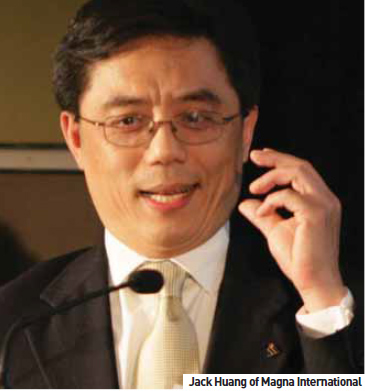 would definitely look at the offering from a Chinese machine maker, look at the function aspect and at their price. Quite simply, if we can buy the same function at a cheaper price, we will go for it.” Huang has some experience of Chinese electronics manufacturing equipment, chip shooters, etc, as he is in the process of specifying a series of new electronics plants in China. “I know that I can buy the same equipment in China for probably one third of the cost (of an equivalent Western machine), but I also know that the reliability expectation is two or three years.”
would definitely look at the offering from a Chinese machine maker, look at the function aspect and at their price. Quite simply, if we can buy the same function at a cheaper price, we will go for it.” Huang has some experience of Chinese electronics manufacturing equipment, chip shooters, etc, as he is in the process of specifying a series of new electronics plants in China. “I know that I can buy the same equipment in China for probably one third of the cost (of an equivalent Western machine), but I also know that the reliability expectation is two or three years.”
Huang’s take on labour issues is also a little different: “In China, almost all the hourly workers are invariably from far away. This means as a company, we have to provide transportation and housing. This can also be a problem during holidays like the Chinese New Year; often a lot of people will go home and you may have to shut down your operation.”
A widespread belief held by some Western companies is that there is a big difference in salary and employment conditions between big cities and the more rural areas; a hangover view from the days of total collectivisation? Jack Huang: “In some of the smaller cities you actually find a more stable workforce, as they more often live locally. In Shanghai, one will have a very dedicated workforce as many people want to come to the city to work as the wages are much better than in the countryside.”
Magna is known in the industry for its manufacturing system; its nurturing attitude towards its staff. In both Europe and North America, the company’s retention rate of skilled and semi-skilled labour is very high. In light of this, how does Huang operate his manufacturing and labour management system? “A good manager should definitely want to adopt the Magna philosophy; but do it step by step. When Magna takes over a local plant, the change should be made carefully. Do it overnight and that could be a disaster.”
Huang admires the Toyota Total Production System (TPS) and favours its simpler, human-centred approach to manufacturing over employing expensive machinery, simply because it is available: “I agree with the TPS, things should be kept simple, one should spend as little as possible on machinery and work to develop the workforce. This may not always fit in with the Chinese philosophy of making things, sometimes it seems that people think that extra equipment can help to produce a good product, but that is not always the answer.”
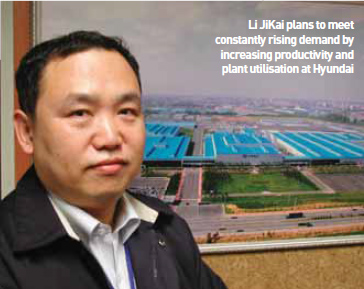 Quality by numbers
Quality by numbers
Raising quality levels through the purchase of sometimes complex equipment is one of the great drivers for manufacturing managers in China. Huang tempers this policy with caution: “Yes, better production machinery will give you better quality, but only if you know how to use. To me, I would challenge the equipment manufacturers, particularly in these tough economic times, to introduce more flexibility in their products, make them suitable for more diverse tasks. At the moment we want more flexible assembly work cells; in the past we have had dedicated cells for digital (electronic) products, we now want work cells that can make components for more than one customer. It comes back to the TPS – using poka yoke (mistake proofing) for example.”
As Si Lei at Great Wall notes, many Chinese suppliers still do not have an efficient MRP – or any MRP system - in place, and this also concerns Jack Huang: “A good investment for a company is an MRP system; some of the local companies (suppliers) do not have this. If a supplier does not have an MRP system in place, the chances are that they will not be a supplier for very long.”


































